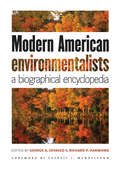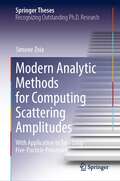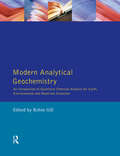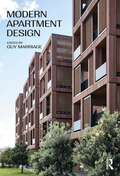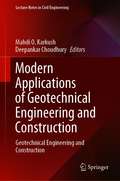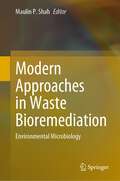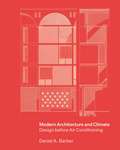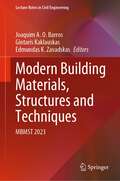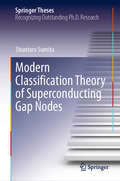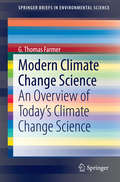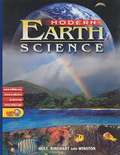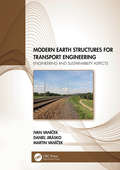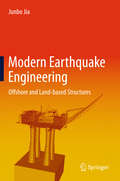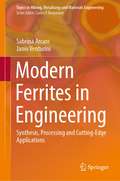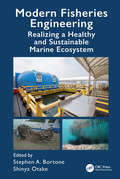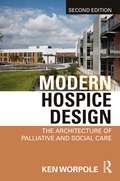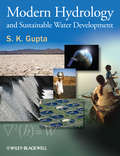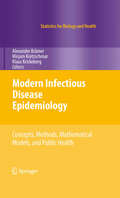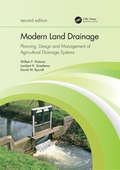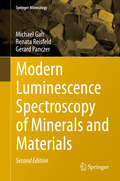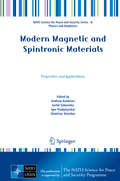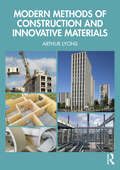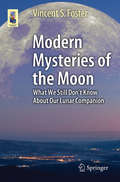- Table View
- List View
Modern American Environmentalists: A Biographical Encyclopedia
by George A. Cevasco Richard P. HarmondModern American Environmentalists profiles the lives and contributions of nearly 140 major figures during the twentieth-century environmental movement. Included are iconic environmentalists such as Rachel Carson, E. O. Wilson, Gifford Pinchot, and Al Gore, and important but less expected names, including John Steinbeck and Allen Ginsberg. The entries recount how each individual became active in environmental conservation, detail his or her significant contributions, trace the influence of each on future efforts, and discuss the person's legacy. The individuals selected for the book displayed either an unparalleled commitment to the conservation, preservation, restoration, and enhancement of the natural environment or made a major contribution to the growth of environmentalism during its first century. With a foreword by environmental historian Everett I. Mendolsohn, a time line of key environmental events, a bibliography of groundbreaking works, and an index organized by specialization, this biographical encyclopedia is a handy and complete guide to the major people involved in the modern American environmental movement.
Modern Analytic Methods for Computing Scattering Amplitudes: With Application to Two-Loop Five-Particle Processes (Springer Theses)
by Simone ZoiaThis work presents some essential techniques that constitute the modern strategy for computing scattering amplitudes. It begins with an introductory chapter to fill the gap between a standard QFT course and the latest developments in the field. The author then tackles the main bottleneck: the computation of the loop Feynman integrals. The most efficient technique for their computation is the method of the differential equations. This is discussed in detail, with a particular focus on the mathematical aspects involved in the derivation of the differential equations and their solution. Ample space is devoted to the special functions arising from the differential equations, to their analytic properties, and to the mathematical techniques which allow us to handle them systematically. The thesis also addresses the application of these techniques to a cutting-edge problem of importance for the physics programme of the Large Hadron Collider: five-particle amplitudes at two-loop order. It presents the first analytic results for complete two-loop five-particle amplitudes, in supersymmetric theories and QCD. The techniques discussed here open the door to precision phenomenology for processes of phenomenological interest, such as three-photon, three-jet, and di-photon + jet production.
Modern Analytical Geochemistry: An Introduction to Quantitative Chemical Analysis Techniques for Earth, Environmental and Materials Scientists (Longman Geochemistry Series)
by Robin GillA comprehensive handbook of analytical techniques in geochemistry which provides the student and the professional with an understanding of the wide spectrum of different analytical methods that can be applied to Earth and environmental materials, together with a critical appreciation of their relative merits and limitations.
Modern Apartment Design
by Guy MarriageModern Apartment Design provides guidelines to the design of modern apartment buildings as well as a summation of current cutting-edge practice in engineered timber construction. The book covers a brief history of apartment buildings around the world, with a broad outline of different types of apartment blocks. It has a strong focus on the design and actual construction of apartment buildings, especially those utilising mass timber, such as cross-laminated timber and laminated veneer lumber. It also features six Case Study chapters from industry-leading practitioners in the area, enabling best practice in architecture and engineering of these new apartment building types to be more widely understood and propagated worldwide. The fully illustrated, full-colour case studies span the globe and include: Clearwater Quay in Christchurch, New Zealand (Pacific Environments NZ); Wynyard Central East 2 in Auckland, New Zealand (Architectus); Dalton Works in London, UK (Waugh Thistleton Architects); Mjøstårnet, Brumunddal, Norway (Voll Arkitekter); Brock Commons Tallwood House student housing in Vancouver, Canada (Acton Ostry Architects); and Regensbergstrasse apartments in Zurich, Switzerland (Dreicon). The book will be of great interest to architects and architecture students.
Modern Applications of Geotechnical Engineering and Construction: Geotechnical Engineering and Construction (Lecture Notes in Civil Engineering #112)
by Deepankar Choudhury Mahdi O. KarkushThis book contains select papers from the International Conference on Geotechnical Engineering Iraq discussing the challenges, opportunities, and problems of application of geotechnical engineering in projects. The contents cover a wide spectrum of themes in geotechnical engineering, including but not limited to sustainability & geotechnical engineering, modeling of foundations & slope stability, seismic analysis & soil mechanics, construction materials, and construction & management of projects. This volume will prove a valuable resource for practicing engineers and researchers in the field of geotechnical engineering, structural engineering, and construction and management of projects.^
Modern Approaches in Waste Bioremediation: Environmental Microbiology
by Maulin P. ShahThe book highlights the importance of newly developed bioremediation technologies in industrial waste treatment to clean up the environment from pollution caused by human activities. It assesses the potential application of several existing bioremediation techniques and introduces new emerging and application-based technologies.This technology includes several techniques such as bio-stimulation, bio-generation, bioaccumulation, biosorption, physical correction and rhyming-emission. This book describes the limitations and challenges associated with some generally accepted bioremediation strategies and evaluate the possible applications of these corrective strategies to eliminate toxic pollutants from the environment through integrated Technologies in Industrial wastewater treatment.
Modern Architecture and Climate: Design before Air Conditioning
by Daniel A. BarberHow climate influenced the design strategies of modernist architectsModern Architecture and Climate explores how leading architects of the twentieth century incorporated climate-mediating strategies into their designs, and shows how regional approaches to climate adaptability were essential to the development of modern architecture. Focusing on the period surrounding World War II—before fossil-fuel powered air-conditioning became widely available—Daniel Barber brings to light a vibrant and dynamic architectural discussion involving design, materials, and shading systems as means of interior climate control. He looks at projects by well-known architects such as Richard Neutra, Le Corbusier, Lúcio Costa, Mies van der Rohe, and Skidmore, Owings, and Merrill, and the work of climate-focused architects such as MMM Roberto, Olgyay and Olgyay, and Cliff May. Drawing on the editorial projects of James Marston Fitch, Elizabeth Gordon, and others, he demonstrates how images and diagrams produced by architects helped conceptualize climate knowledge, alongside the work of meteorologists, physicists, engineers, and social scientists. Barber describes how this novel type of environmental media catalyzed new ways of thinking about climate and architectural design.Extensively illustrated with archival material, Modern Architecture and Climate provides global perspectives on modern architecture and its evolving relationship with a changing climate, showcasing designs from Latin America, Europe, the United States, the Middle East, and Africa. This timely and important book reconciles the cultural dynamism of architecture with the material realities of ever-increasing carbon emissions from the mechanical cooling systems of buildings and offers a historical foundation for today’s zero-carbon design.
Modern Building Materials, Structures and Techniques: MBMST 2023 (Lecture Notes in Civil Engineering #392)
by Joaquim A. O. Barros Gintaris Kaklauskas Edmundas K. ZavadskasThis book gathers the latest advances, innovations and applications in the field of sustainable construction materials and structures, as presented by leading international researchers and engineers at the 14th International scientific conference “Modern Building Materials, Structures and Techniques” (MBMST 2023), held in Vilnius, Lithuania, on 5–6 October 2023. It covers topics such as modern building materials and their production technologies; investigation and design of reinforced concrete, steel, glass, timber and composite structures; innovative calculation techniques for bridges; geotechnics; new building technologies and management; and building information modelling. The contributions, which were selected through a rigorous international peer-reviewed process, share exciting ideas that will spur novel research directions and foster new multidisciplinary collaborations.
Modern Classification Theory of Superconducting Gap Nodes (Springer Theses)
by Shuntaro SumitaThis book puts forward a modern classification theory for superconducting gap nodes, whose structures can be observed by experiments and are essential for understanding unconventional superconductivity. In the first part of the book, the classification method, based on group theory and K theory, is introduced in a step-by-step, pedagogical way. In turn, the latter part presents comprehensive classification tables, which include various nontrivial gap (node) structures, which are not predicted by the Sigrist-Ueda method, but are by the new method. The results obtained here show that crystal symmetry and/or angular momentum impose critical constraints on the superconducting gap structures. Lastly, the book lists a range of candidate superconductors for the nontrivial gap nodes. The classification methods and tables presented here offer an essential basis for further investigations into unconventional superconductivity. They indicate that previous experimental studies should be reinterpreted, while future experiments should reflect the new excitation spectrum.
Modern Climate Change Science
by G. Thomas FarmerComposed of two extensive sections, this book surveys important work in climate change science, mainly in the United States, and introduces contributions to the body of science that have arrived on the scene between January 2013 and February 2014. The opening section offers a broad examination of contemporary climate change science, with subsections on the Intergovernmental Panel on Climate Change (IPCC); Earth's energy imbalance and energy flow; carbon dioxide's role in the greenhouse effect; climate forcing, and climate feedbacks; Charles David Keeling and the Keeling Curve; the interfaces of atmosphere with oceans and land; paleoclimates and paleoclimatology; rising sea level; melting glaciers; deforestation; desertification; more violent storms, animal and human migration, extinction of species and more. The second section reviews and assesses the newest contributions to the body of research. Among the topics discussed are current and recent research on rising temperatures; the BEST study; the Global Historical Climatology Network (GHCN) and the National Climatic Data Center (NCDC); current and recent research on climate models, new research on global warming 56 million years ago; ecosystem impacts, projections of future climate and more. This book can be considered a bridge between the volumes of Farmer and Cook's Climate Change Science: A Modern Synthesis, as it arrives between the release of the first volume on the Physical Climate (2013) the second, on Earth's climate history, which is now in preparation. The book benefits a wide audience as its survey of the science of climate change provides an introduction to the subject and a discussion of current research in the field. The book may be used as a refresher for those who have had prior courses in climate science and related fields. Each chapter includes a comprehensive list of references for subjects discussed in the text.
Modern Earth Science
by Robert J. Sager William L. Ramsey Clifford R. Phillips Frank M. WatenpaughStudying the earth is like putting together a complex jigsaw puzzle that is made up of pieces that are constantly changing shape. As time passes, many of the pieces change so much they don't even resemble their original shape.
Modern Earth Science
by Robert J. Sager William L. Ramsey Clifford R. Phillips Frank M. WatenpaughStudying the earth is like putting together a complex jigsaw puzzle that is made up of pieces that are constantly changing shape. As time passes, many of the pieces change so much they don't even resemble their original shape.
Modern Earth Structures for Transport Engineering: Engineering and Sustainability Aspects
by Ivan Vaníček Daniel Jirásko Martin VaníčekNowadays, demands on modern civil engineering structures require not only safe technical solutions, but also additional approaches, involving ecological, sociological and economical aspects. This book reacts on these new requirements with a focus on earth structures for transport engineering, mainly for motorways and railways. Technical demands have to be adequately related to the risk with which the design and execution are connected. Soil used for the construction, together with subsoil, are natural materials with a high degree of inhomogeneity. Therefore, the risk when constructing with such materials is much higher than for structures utilizing man-made materials. The engineering approach is firstly focused on the geotechnical risk identification and subsequently on the reduction of this risk. Geotechnical risk is linked to the uncertainties for individual phases of the design and construction processes. Ground model, geotechnical design model, calculation model and structure execution are the main phases of the above-mentioned processes. Risk reduction involves the lowering of the range of uncertainties for individual phases, guaranteeing safe and optimal technical solutions. Eurocode 7 "Geotechnical design" creates a general frame of this risk identification and reduction approach. Earth structures are offering great opportunities for sustainability approach. Therefore, the possibilities how to decrease consumption of land (greenfields), energy and natural aggregates are at the centre of interest. In parallel to sustainability, the principles of availability and affordability for transport infrastructures are discussed. The main aim there is to eliminate the impact of interaction of the transport infrastructure with natural and man-made hazards, thus guaranteeing long-term functionality. This book will be of interest to specialists responsible for transport infrastructure planning, investors (project owners) of motorways and railways and environmental engineers. The main focus is on those responsible for geotechnical investigations, earth structures design and on contractors of such structures.
Modern Earthquake Engineering
by Junbo JiaThis book focuses on the application of earthquake engineering to offshore infrastructures. It is self-contained as a reference work and covers a wide range of topics, including seismology, geotechnical engineering, and marine structural engineering, as well as special chapters on tsunamis, the seismic performance of arctic structures, and the sudden subsidence of platforms. The target readers include professionals in offshore and civil engineering, officials and regulators, as well as researchers and students in this field.
Modern Ferrites in Engineering: Synthesis, Processing and Cutting-Edge Applications (Topics in Mining, Metallurgy and Materials Engineering)
by Sabrina Arcaro Janio VenturiniThis book summarizes the state-of-the-art knowledge on ferrites as well as the cutting-edge applications of these versatile materials. The main families of ferrites and their modern synthesis and processing methods are covered in this review book. Furthermore, the different morphologies of these materials and their current and incipient applications are also discussed.
Modern Fisheries Engineering: Realizing a Healthy and Sustainable Marine Ecosystem
by Stephen A. Bortone and Shinya OtakeModern Fisheries Engineering: Realizing a Healthy and Sustainable Marine Ecosystem is a compendium of the latest and most cutting-edge information on the diversity of technical aspects associated with Fisheries Engineering. Expanding on presentations given at the International Conference on Fisheries Engineering (ICFE) held in Nagasaki in 2019, it aims to encourage and inspire future generations of young researchers in the field. Topics include artificial reefs, ocean ranching, fishing gear developments, modern monitoring technologies, and other subjects related to the latest practices for conducting efficient, sustainable fishing. This volume brings together world authorities to address a critically important topic, with a fresh and modern approach that includes the latest development in environmental and fisheries science.
Modern Hospice Design: The Architecture of Palliative and Social Care
by Ken WorpoleThe new edition of this acclaimed book comprehensively updates its timely advocacy of the need for good quality palliative care, today more necessary than ever. Rooted in the social history of the care of the elderly and terminally ill, Modern Hospice Design: The Architecture of Palliative and Social Care takes cognisance of the new conditions of social care in the 21st century, principally in the UK, Europe and North America. It does so with regard to the development of new building types, but also in response to new philosophies of palliative care and the status of the elderly and the dying. Benefitting from a clearer methodological approach and conceptual framework, the expanded book allows a broad section of readers to navigate the text more easily. At its core is a public discussion of a philosophy of design for providing care for the elderly and the vulnerable, taking the importance of architectural aesthetics, the use of quality materials, the porousness of design to the wider world, and the integration of indoor and outdoor spaces as part of the overall care environment. In doing so it advocates care settings that, in the words of Maggie Jencks whose life and ideas inspired the Maggie’s Centres, ‘rise to the occasion’. Including new chapters and new in-depth case studies, complete will full colour illustrations, this book is for architects and interior designers and their students, healthcare professionals, social care providers, estate and facility managers, hospital administrators and Healthcare Trust Boards.
Modern Hydrology and Sustainable Water Development
by S. K. GuptaThe material of this book will derive its scientific under-pinning from basics of mathematics, physics, chemistry, geology, meteorology, engineering, soil science, and related disciplines and will provide sufficient breadth and depth of understanding in each sub-section of hydrology. It will start with basic concepts: Water, its properties, its movement, modelling and quality The distribution of water in space and time Water resource sustainability Chapters on ‘global change’ and ‘water and ethics’ aim respectively to emphasize the central role of hydrological cycle and its quantitative understanding and monitoring for human well being and to familiarize the readers with complex issues of equity and justice in large scale water resource development process. Modern Hydrology for Sustainable Development is intended not only as a textbook for students in earth and environmental science and civil engineering degree courses, but also as a reference for professionals in fields as diverse as environmental planning, civil engineering, municipal and industrial water supply, irrigation and catchment management.
Modern Infectious Disease Epidemiology
by Mirjam Kretzschmar Alexander Krämer Klaus KrickebergHardly a day goes by without news headlines concerning infectious disease threats. Currently the spectre of a pandemic of influenza A|H1N1 is raising its head, and heated debates are taking place about the pro's and con's of vaccinating young girls against human papilloma virus. For an evidence-based and responsible communication of infectious disease topics to avoid misunderstandings and overreaction of the public, we need solid scientific knowledge and an understanding of all aspects of infectious diseases and their control. The aim of our book is to present the reader with the general picture and the main ideas of the subject. The book introduces the reader to methodological aspects of epidemiology that are specific for infectious diseases and provides insight into the epidemiology of some classes of infectious diseases characterized by their main modes of transmission. This choice of topics bridges the gap between scientific research on the clinical, biological, mathematical, social and economic aspects of infectious diseases and their applications in public health. The book will help the reader to understand the impact of infectious diseases on modern society and the instruments that policy makers have at their disposal to deal with these challenges. It is written for students of the health sciences, both of curative medicine and public health, and for experts that are active in these and related domains, and it may be of interest for the educated layman since the technical level is kept relatively low.
Modern Introduction to Surface Plasmons: Theory, Mathematica Modeling and Applications
by Dror Sarid William A. ChallenerIntroducing graduate students in physics, optics, materials science and electrical engineering to surface plasmons, this 2010 book also covers guided modes at planar interfaces of metamaterials with negative refractive index. The physics of localized and propagating surface plasmons, on planar films, gratings, nanowires and nanoparticles, is developed using both analytical and numerical techniques. Guided modes at the interfaces between materials with any combination of positive or negative permittivity and permeability are analyzed in a systematic manner. Applications of surface plasmon physics are described, including near-field transducers in heat-assisted magnetic recording and biosensors. Resources at www. cambridge. org/9780521767170 include Mathematica code to generate figures from the book, color versions of many figures, and extended discussion of topics such as vector diffraction theory.
Modern Land Drainage: Planning, Design and Management of Agricultural Drainage Systems
by Willem F. Vlotman Lambert K. Smedema David W. RycroftModern Land Drainage 2nd edition is a fully revised and updated edition of the 2004 edition. Modern Land Drainage describes traditional drainage formulas (Hooghoudt, Kirkham, Donnan, Ernst, Glover-Dumm) for rainfed agriculture in the humid temperature zone. Significant parts are devoted to drainage for salinity control of irrigated land in (semi-) arid zones, and to drainage of rice land in the humid tropics. Institutional, management and maintenance aspects are extensively covered, as well as the mitigation of adverse impacts of drainage interventions on the environment. The latest computer applications for drainage design in the context of integrated water management are described (DRAINMOD, HEC, SWAP, etc.). Field surveys are executed by governments, with the aid of consultants, but rarely are the end stakeholders (i.e., farmers and general public) involved from inception to planning to execution of a drainage system. Yet, during the Operation, Management and Maintenance (OMM) phase of a water management system, they are expected to takeover, run, bear and be responsible for the costs of OMM. The book describes successful methodologies and processes to be followed for engagement of stakeholders at all levels, from government to farm, from minister to farmer, and, from beginning to end. The book covers all aspects needed for sustainable drainage. The latest survey methodologies with satellites and drones are suggested to assess cause and effect. Waterlogging and salinity are the effect of something caused most likely upstream of the drainage problem location. Hence treating the cause may be more cost-effective. Triple Bottom Line (social, environmental and financial considerations) and the water-food-energy nexus are an integral part of the drainage design process. Controlled drainage, i.e. the balance of removal and conservation of drainage water and minimising solute transport as low as reasonably achievable (ALARA principle) is extensively described. This work is intended for use both as a university level textbook and as a professional handbook; it is of particular value to professionals engaged in drainage development in the context of integrated water resources and river basin management, civil and agricultural engineers, government officials, university students and libraries.
Modern Luminescence Spectroscopy of Minerals and Materials
by Michael Gaft Renata Reisfeld Gerard PanczerThe book is devoted to three types of laser-based spectroscopy of minerals, namely Laser-Induced Time-Resolved Luminescence, Laser-Induced Breakdown spectroscopy and Gated Raman Spectroscopy. This new edition presents the main new data, which have been received after the publication of the first edition ten years ago both by the authors and by other researchers. During this time, only the authors published more than 50 original papers devoted to laser-based spectroscopy of minerals. A lot of new data have been accumulated, both in fundamental and applied aspects, which are presented in new edition.
Modern Magnetic and Spintronic Materials: Properties and Applications (NATO Science for Peace and Security Series B: Physics and Biophysics)
by Andreas Kaidatzis Serhii Sidorenko Igor Vladymyrskyi Dimitrios NiarchosMagnetic and spintronic materials are ubiquitous in modern technological applications, e.g. in electric motors, power generators, sensors and actuators, not to mention information storage and processing. Medical technology has also greatly benefited from magnetic materials – especially magnetic nanoparticles – for therapy and diagnostics methods. All of the above-mentioned applications rely on the properties of the materials used. These properties in turn depend on intrinsic and extrinsic material parameters. The former are related to the actual elements used and their properties, e.g. atomic magnetic moment and exchange interaction between atoms; the latter are related to the structural and microstructural properties of the materials used, e.g. their crystal structure, grain size, and grain boundary phases. Focusing on state-of-the-art magnetic and spintronic materials, this book will introduce readers to a range of related topics in Physics and Materials Science. Phenomena and processes at the nanoscale are of particular importance in this context; accordingly, much of the book addresses such topics.
Modern Methods of Construction and Innovative Materials
by Arthur LyonsThis new textbook has two main themes. The first is Modern Methods of Construction (MMC) which is the off-site manufacture of a wide spectrum of products, ranging from whole buildings to be transported onto site, down to smaller units or components for site integration. The second theme describes the innovation and progress towards carbon zero by the major generators of CO2 in the construction industry – namely cement, steel and masonry.The first section of the book describes and illustrates with photographs, the major forms of Modern Methods of Construction. These include fully completed 3D units, panelised systems, pods, sub-assemblies and on-site MMC. The section on Innovative Materials then describes a wide range of construction products which are entering into the built environment sector. Some new entrants are variants on well-established construction materials such as steel and concrete. Materials such as these will remain major construction materials for the foreseeable future, but their composition and manufacturing processes will inevitably have to change. Timber also will remain a major construction material, but sustainable sourcing is key and its utilisation as cross-lamination timber (CLT) or as modified timber is rapidly developing. As a result, students and practitioners must familiarise themselves with these materials, their composition, and various uses.The book goes on to describe variants of other traditional building products, such as glass, plastic and insulation, which are undergoing major developments leading towards enhanced environmental sustainability, as well as many emergent materials, some of which are likely to be significant in future. Modern Methods of Construction and Innovative Materials is the only book combining these important elements of the future of the industry in an easy-to-read guide for students and new practitioners. It is essential reading for anyone studying and working in the built environment, be they architects, construction managers, surveyors or engineers.
Modern Mysteries of the Moon
by Vincent S. FosterThere are still many questions that remain about the Moon, which this book examines. From concentric craters to lunar swirls, water vapor and lunar reverberations on impact, Foster collects it all for a fascinating tour that will illuminate the backyard observer's understanding of this easily viewed, yet also imperfectly understood, celestial object. Data from Apollo and a flotilla of unmanned Moon orbiters, crashers, and landers have all contributed to our understanding of the Moon, but these mysteries linger despite decades of research. When Project Apollo brought back lunar rocks and soil samples, it opened a new chapter of understanding Earth's lone natural satellite, a process that continues to this day, as old results are revisited and new techniques are used on existing samples. Topics such as the origin, evolution, structure and composition of the Moon, however, are still under debate. Lunar research is still an active field of study. New technologies make it possible to continue to learn. But even so, the Moon continues to hold tight to some of its oldest and most cherished secrets. Foster examines many of the most interesting puzzles and what has been revealed by exploring them - as well as what questions remain.
